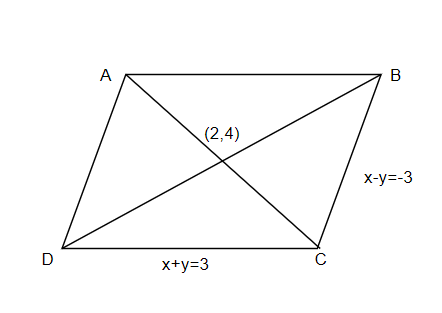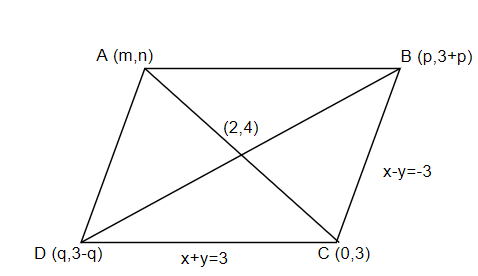
Answer
503.1k+ views
Hint: Solve the 2 line equations to find the coordinates of intersection of these 2 lines and use section formula to find the remaining coordinates of a parallelogram.
The equations given in the question are,
\[x+y=3\] and \[x-y+3=0\]
They can be rewritten as,
\[x+y=3\] and \[x-y=-3\]
Also, it is given that the diagonals intersect at \[(2,4)\]. Draw the parallelogram representing the given data as shown below,

AThe vertex C is a point that intersects the lines DC and BC. Therefore, the coordinates of the C can be obtained by adding and solving the two equations of the lines as below,
\[\dfrac{\begin{align}
& x+y=3 \\
& x-y=-3 \\
\end{align}}{\begin{align}
& 2x=0 \\
& x=0 \\
\end{align}}\]
Substituting the value of \[x\], we have the value of \[y\] as,
\[\begin{align}
& 0+y=3 \\
& \Rightarrow y=3 \\
\end{align}\]
Therefore, the coordinates of C are \[(0,3)\].
The coordinates of vertex B can be obtained by supposing \[x=p\]in the equation \[x-y=-3\]. So, we have the coordinates as \[(p,3+p)\]. To get the coordinates of vertex D, suppose \[x=q\]in the equation \[x+y=3\]. So, we have the coordinates as \[(q,3-q)\]. Let the coordinates of vertex A be \[(m,n)\]. The figure can be redrawn with the above details as below,

The coordinates of the point of intersection of the diagonals are given as \[(2,4)\]. The point of intersection is the midpoint of the line AC as well as the line BD. It divides the lines in the ratio \[1:1\].
Using the section formula, the coordinates of vertex A \[(m,n)\] can be found as,
\[\left( \dfrac{m+0}{2},\dfrac{n+3}{2} \right)=\left( 2,4 \right)\]
Equating both coordinates on either sides,
\[\begin{align}
& \dfrac{m}{2}=2,\dfrac{n+3}{2}=4 \\
& m=4,n=(8-3) \\
& m=4,n=5 \\
\end{align}\]
Therefore, coordinates of A are \[(4,5)\].
Using section formula to find the coordinates of D and B,
\[\begin{align}
& \left( \dfrac{p+q}{2},\dfrac{3+p+3-q}{2} \right)=(2,4) \\
& \left( \dfrac{p+q}{2},\dfrac{p-q+6}{2} \right)=(2,4) \\
\end{align}\]
Equating both coordinates on either sides,
\[\begin{align}
& p+q=4,p-q=(8-6) \\
& p+q=4,p-q=2 \\
\end{align}\]
We get two equations \[p+q=4\] and \[p-q=2\]. Adding and solving the two equations,
\[\dfrac{\begin{align}
& p+q=4 \\
& p-q=2 \\
\end{align}}{\begin{align}
& 2p=6 \\
& p=3 \\
\end{align}}\]
Substituting the value of \[p\], we have the value of \[q\] as,
\[\begin{align}
& 3+q=4 \\
& q=1 \\
\end{align}\]
Now, re-substituting these values, we can get the coordinates of B and D as,
B\[(p,3+p)\Rightarrow (3,3+3)=(3,6)\]
D\[(q,3-q)\Rightarrow (1,3-1)=(1,2)\]
Looking at the options, the only possible answer is the coordinates of B, which is \[(3,6)\].
Therefore, we get option (d) as the correct answer.
Note: One way in which this problem could go wrong is by interchanging the coordinates of B and D which are written in terms of \[p\] and \[q\]. If you write the coordinates as \[(3+p,p)\] and \[(3-q,q)\] instead of \[(p,3+p)\]and \[(q,3-q)\], you might end up getting the coordinates as \[(6,3)\] and \[(2,1)\] and choose the wrong option.
The equations given in the question are,
\[x+y=3\] and \[x-y+3=0\]
They can be rewritten as,
\[x+y=3\] and \[x-y=-3\]
Also, it is given that the diagonals intersect at \[(2,4)\]. Draw the parallelogram representing the given data as shown below,

AThe vertex C is a point that intersects the lines DC and BC. Therefore, the coordinates of the C can be obtained by adding and solving the two equations of the lines as below,
\[\dfrac{\begin{align}
& x+y=3 \\
& x-y=-3 \\
\end{align}}{\begin{align}
& 2x=0 \\
& x=0 \\
\end{align}}\]
Substituting the value of \[x\], we have the value of \[y\] as,
\[\begin{align}
& 0+y=3 \\
& \Rightarrow y=3 \\
\end{align}\]
Therefore, the coordinates of C are \[(0,3)\].
The coordinates of vertex B can be obtained by supposing \[x=p\]in the equation \[x-y=-3\]. So, we have the coordinates as \[(p,3+p)\]. To get the coordinates of vertex D, suppose \[x=q\]in the equation \[x+y=3\]. So, we have the coordinates as \[(q,3-q)\]. Let the coordinates of vertex A be \[(m,n)\]. The figure can be redrawn with the above details as below,

The coordinates of the point of intersection of the diagonals are given as \[(2,4)\]. The point of intersection is the midpoint of the line AC as well as the line BD. It divides the lines in the ratio \[1:1\].
Using the section formula, the coordinates of vertex A \[(m,n)\] can be found as,
\[\left( \dfrac{m+0}{2},\dfrac{n+3}{2} \right)=\left( 2,4 \right)\]
Equating both coordinates on either sides,
\[\begin{align}
& \dfrac{m}{2}=2,\dfrac{n+3}{2}=4 \\
& m=4,n=(8-3) \\
& m=4,n=5 \\
\end{align}\]
Therefore, coordinates of A are \[(4,5)\].
Using section formula to find the coordinates of D and B,
\[\begin{align}
& \left( \dfrac{p+q}{2},\dfrac{3+p+3-q}{2} \right)=(2,4) \\
& \left( \dfrac{p+q}{2},\dfrac{p-q+6}{2} \right)=(2,4) \\
\end{align}\]
Equating both coordinates on either sides,
\[\begin{align}
& p+q=4,p-q=(8-6) \\
& p+q=4,p-q=2 \\
\end{align}\]
We get two equations \[p+q=4\] and \[p-q=2\]. Adding and solving the two equations,
\[\dfrac{\begin{align}
& p+q=4 \\
& p-q=2 \\
\end{align}}{\begin{align}
& 2p=6 \\
& p=3 \\
\end{align}}\]
Substituting the value of \[p\], we have the value of \[q\] as,
\[\begin{align}
& 3+q=4 \\
& q=1 \\
\end{align}\]
Now, re-substituting these values, we can get the coordinates of B and D as,
B\[(p,3+p)\Rightarrow (3,3+3)=(3,6)\]
D\[(q,3-q)\Rightarrow (1,3-1)=(1,2)\]
Looking at the options, the only possible answer is the coordinates of B, which is \[(3,6)\].
Therefore, we get option (d) as the correct answer.
Note: One way in which this problem could go wrong is by interchanging the coordinates of B and D which are written in terms of \[p\] and \[q\]. If you write the coordinates as \[(3+p,p)\] and \[(3-q,q)\] instead of \[(p,3+p)\]and \[(q,3-q)\], you might end up getting the coordinates as \[(6,3)\] and \[(2,1)\] and choose the wrong option.
Recently Updated Pages
Fill in the blanks with suitable prepositions Break class 10 english CBSE

Fill in the blanks with suitable articles Tribune is class 10 english CBSE

Rearrange the following words and phrases to form a class 10 english CBSE

Select the opposite of the given word Permit aGive class 10 english CBSE

Fill in the blank with the most appropriate option class 10 english CBSE

Some places have oneline notices Which option is a class 10 english CBSE

Trending doubts
Fill the blanks with the suitable prepositions 1 The class 9 english CBSE

How do you graph the function fx 4x class 9 maths CBSE

When was Karauli Praja Mandal established 11934 21936 class 10 social science CBSE

Which are the Top 10 Largest Countries of the World?

What is the definite integral of zero a constant b class 12 maths CBSE

Why is steel more elastic than rubber class 11 physics CBSE

Distinguish between the following Ferrous and nonferrous class 9 social science CBSE

The Equation xxx + 2 is Satisfied when x is Equal to Class 10 Maths

Differentiate between homogeneous and heterogeneous class 12 chemistry CBSE




